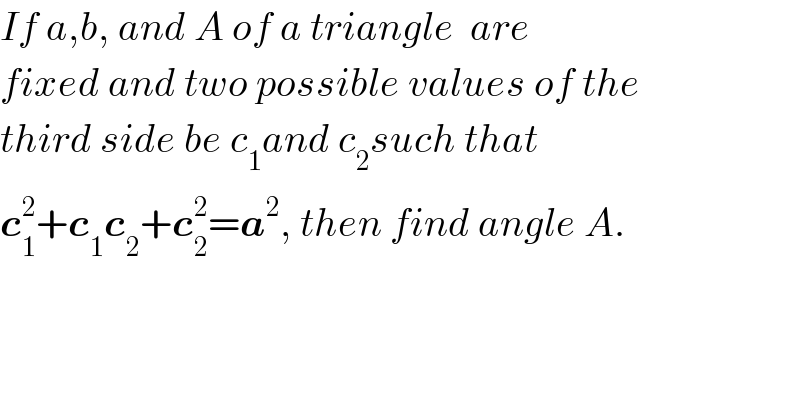
Question Number 21889 by ajfour last updated on 06/Oct/17

$${If}\:{a},{b},\:{and}\:{A}\:{of}\:{a}\:{triangle}\:\:{are}\: \\ $$$${fixed}\:{and}\:{two}\:{possible}\:{values}\:{of}\:{the}\: \\ $$$${third}\:{side}\:{be}\:{c}_{\mathrm{1}} {and}\:{c}_{\mathrm{2}} {such}\:{that} \\ $$$$\boldsymbol{{c}}_{\mathrm{1}} ^{\mathrm{2}} +\boldsymbol{{c}}_{\mathrm{1}} \boldsymbol{{c}}_{\mathrm{2}} +\boldsymbol{{c}}_{\mathrm{2}} ^{\mathrm{2}} =\boldsymbol{{a}}^{\mathrm{2}} ,\:{then}\:{find}\:{angle}\:{A}. \\ $$
Answered by mrW1 last updated on 06/Oct/17

$$\mathrm{a}^{\mathrm{2}} =\mathrm{b}^{\mathrm{2}} +\mathrm{c}^{\mathrm{2}} −\mathrm{2bc}×\mathrm{cos}\:\mathrm{A} \\ $$$$\Rightarrow\mathrm{c}^{\mathrm{2}} −\left(\mathrm{2b}\:\mathrm{cos}\:\mathrm{A}\right)\mathrm{c}+\left(\mathrm{b}^{\mathrm{2}} −\mathrm{a}^{\mathrm{2}} \right)=\mathrm{0} \\ $$$$\mathrm{c}_{\mathrm{1}} +\mathrm{c}_{\mathrm{2}} =\mathrm{2b}\:\mathrm{cos}\:\mathrm{A} \\ $$$$\mathrm{c}_{\mathrm{1}} \mathrm{c}_{\mathrm{2}} =\mathrm{b}^{\mathrm{2}} −\mathrm{a}^{\mathrm{2}} \\ $$$$ \\ $$$$\boldsymbol{{c}}_{\mathrm{1}} ^{\mathrm{2}} +\boldsymbol{{c}}_{\mathrm{1}} \boldsymbol{{c}}_{\mathrm{2}} +\boldsymbol{{c}}_{\mathrm{2}} ^{\mathrm{2}} =\boldsymbol{{a}}^{\mathrm{2}} \\ $$$$\boldsymbol{{c}}_{\mathrm{1}} ^{\mathrm{2}} +\mathrm{2}\boldsymbol{{c}}_{\mathrm{1}} \boldsymbol{{c}}_{\mathrm{2}} +\boldsymbol{{c}}_{\mathrm{2}} ^{\mathrm{2}} =\boldsymbol{{a}}^{\mathrm{2}} +\mathrm{c}_{\mathrm{1}} \mathrm{c}_{\mathrm{2}} \\ $$$$\left(\mathrm{c}_{\mathrm{1}} +\mathrm{c}_{\mathrm{2}} \right)^{\mathrm{2}} =\mathrm{a}^{\mathrm{2}} +\mathrm{c}_{\mathrm{1}} \mathrm{c}_{\mathrm{2}} \\ $$$$\Rightarrow\mathrm{4b}^{\mathrm{2}} \:\mathrm{cos}^{\mathrm{2}} \:\mathrm{A}=\mathrm{a}^{\mathrm{2}} +\mathrm{b}^{\mathrm{2}} −\mathrm{a}^{\mathrm{2}} =\mathrm{b}^{\mathrm{2}} \\ $$$$\Rightarrow\mathrm{4}\:\mathrm{cos}^{\mathrm{2}} \:\mathrm{A}=\mathrm{1} \\ $$$$\Rightarrow\mathrm{cos}\:\mathrm{A}=\pm\frac{\mathrm{1}}{\mathrm{2}} \\ $$$$\Rightarrow\mathrm{A}=\mathrm{60}°\:\mathrm{or}\:\mathrm{120}° \\ $$
Commented by ajfour last updated on 06/Oct/17

$${thank}\:{you}\:{sir}. \\ $$
